On test: Four 9in battery-powered grinders compared
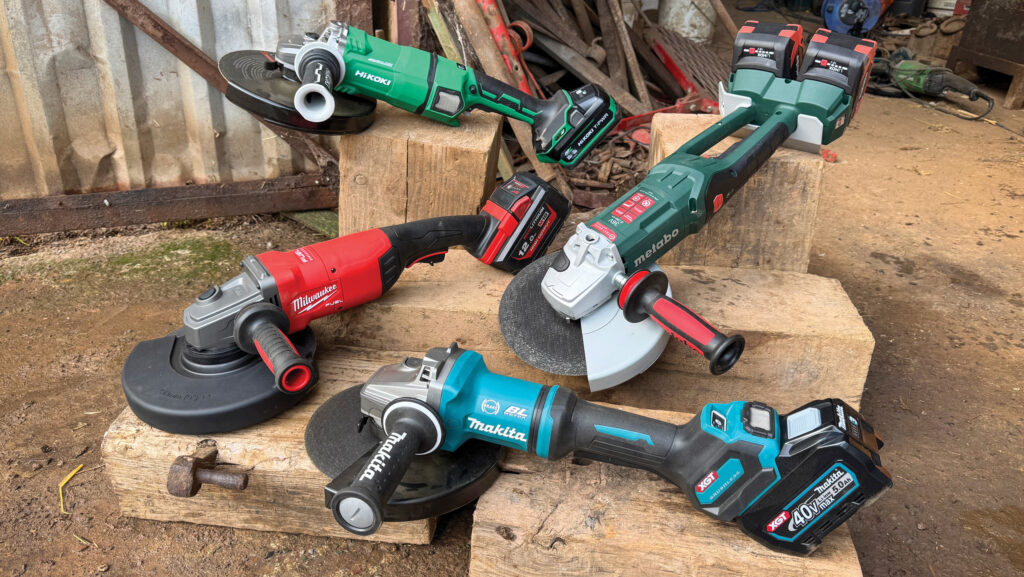 © MAG/Oliver Mark
© MAG/Oliver Mark Cordless power tools are a farm workshop staple these days, and most will run happily on a modestly sized 18V battery.
Yet there remain a few amp-eating beasts for which an altogether beefier supply is required.
See also: On test: We rate the latest battery-powered grease guns
One such example is the 230mm (9in) angle grinder. Slot in a regular 5Ah, 18V pack and it’ll tire faster than Usain Bolt knuckling into a marathon.
So, manufacturers have had to conjure up ways of generating more output.
Some have gone down the doubling-up route, fitting their tools with two docks for 18V batteries wired in series to generate a heftier 36V.
The perk of this approach is that buyers can make use of their existing batteries. However, the tool is often bulkier to handle as a result.
Other techniques include making 18V arrays with far larger capacity (circa 12Ah) or opting for a separate range of higher-voltage batteries.
Then there’s the option of dual voltage packs, which can run at either 18V or 36V depending on which tool they’re slotted into.
To find out which is best we’ve put four big grinders to the test, all of which adopt a slightly different approach to boosting output.
Each was subjected to a range of challenges, including timed cutting tasks in a hefty piece of 25mm steel plate.
We measured both the time it took to perform a 50mm cut and how long they could keep cutting to a single charge.
Here are the results…
Makita GA038G XGT 40V
Best for: Balance
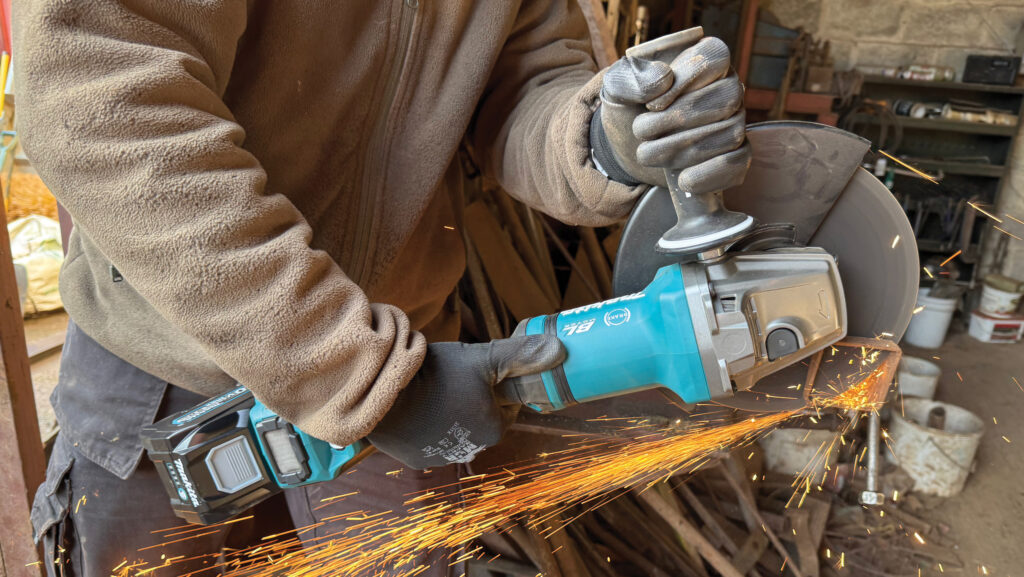
© MAG/Oliver Mark
- Battery system: Single 40V XGT
- Capacity tested: 5Ah
- Biggest battery available: 8Ah
- Weight with battery and cutting disc: 5.5kg
- Disc guard: Tool-free
- Disc attachment: Tool-free Ezynut
- Electronic brake: Yes
- No load speed: 6,600rpm
- Bare tool online price: £239
- Battery online price: £133 (1x 5Ah XGT)
Test results
- Continuous cutting time to a charge: 2min 50sec
- Time to cut 50mm in 25mm thick plate: 32sec
What’s it like?
Makita fans get a choice of 230mm grinder, which will be governed by what batteries they happen to have.
For those wedded to 18V, an LXT tool is available that runs two of these wired in series to give a 36V output.
Then there’s the XGT, which operates on an entirely separate 40V system that requires different batteries and chargers.
These aren’t interchangeable, so even when sticking with the same brand, buyers could find themselves running two incompatible setups.
We’re focusing on the latter in this test, teamed with a 5Ah battery.
Benefits over the 36V alternative are a slightly faster disc speed, a single rather than dual battery pack and easier handling.
How does it perform?
There’s no faulting the XGT grinder when it comes to cutting speed. Disc acceleration is rapid and it lagged just two seconds behind the hefty Metabo in our timed cuts.
That said, it was more liable stop spinning when given grief and the 5Ah battery ran out of steam after just 2min 50sec of continuous cutting.
Interestingly, we were also sent a 2.5Ah pack, but this was only really suited to light work and soon flagged on tougher duties.
If budget allows, a higher capacity 8Ah unit can be purchased. However, this is bigger than the already quite bulky 5Ah block and costs about £200.
In typical Makita fashion, it’s a well-constructed tool that’s nicely balanced, has an easy-to-use trigger and isn’t too heavy.
Another nice touch is the tool-free Ezynut. This makes it quick and simple to mount and dismount discs and it never got too tight for us to undo by hand. And if it does, there’s a supplied tool to help free it off.
The overrun brake was one of the most effective, meaning the disc stops spinning quickly after the trigger is released.
Metabo WPB 36-18 LTX 36V
Best for: Speed of cut
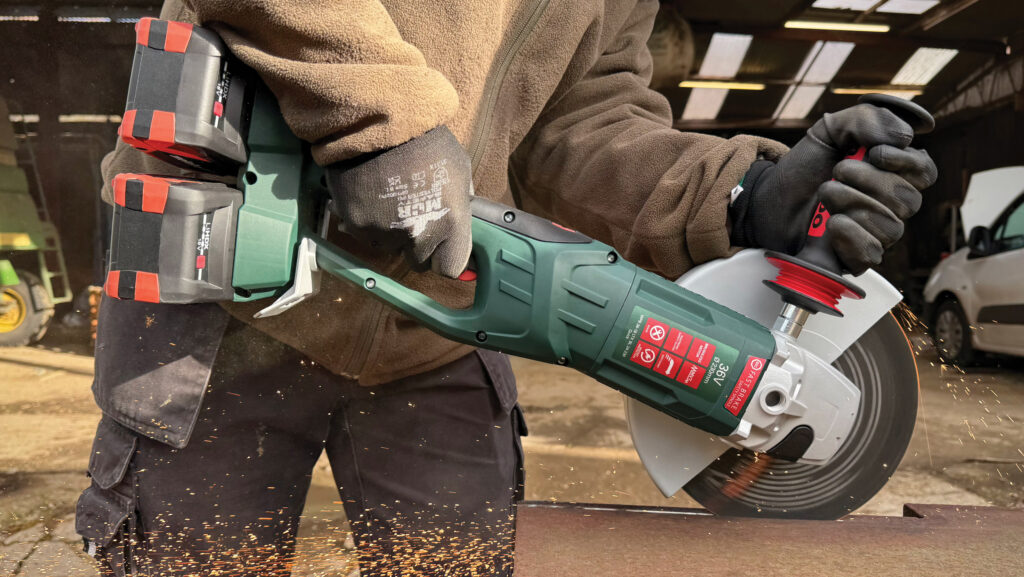
© MAG/Oliver Mark
- Battery system: 36V running twin CAS LiHDX 18V packs
- Capacity tested: 2x 8Ah
- Biggest battery available: 8Ah
- Weight with battery and cutting disc: 7kg
- Disc guard: Tool-free
- Disc attachment: Tool-free
- Electronic brake: Yes
- No load speed: 6,600rpm
- Bare tool online price: £253
- Battery online price: £246 (2x Ah LiHDX)
Test results
- Continuous cutting time to a charge: 4min 37sec
- Time to cut 50mm in 25mm thick plate: 30sec
Power source
It might not be as well-known in farming circles as the likes of Makita and Milwaukee, but German brand Metabo is right up with them in terms of quality.
These days, it’s owned by the same parent company as Hikoki, Koki Holdings, but each operates independently and uses separate power systems.
Featured here is its WPB 36V tool, running on a pair of the latest LiHDX 18V/8Ah tabless batteries.
These are CAS (Cordless Alliance System) compliant, making them interchangeable with more than 40 other tool brands. That said, most of these names will be unfamiliar to people who work in agriculture.
How does it perform?
If cutting speed and performance are your top priority, look no further.
Not only was the WPB the fastest tool to perform a cut, but it seldom bogged down, even when we pushed it as hard as we could.
In fact, it cut as quickly as the host farm’s corded grinder and gave the second longest run time, only bested by sister brand Hikoki.
That said, its superior power meant it performed a slightly longer cut to a charge.
It’s well thought out too, with an easy-to-use trigger, quick-to-adjust disc guard and nifty rotating body that makes it more comfortable to hold in different positions.
There’s also a neat hand-tightening disc nut, similar to that used by Makita.
The penalties are weight and cost. Fully geared up for work, it tips the scales at 7kg (the heaviest by some margin) and the two-battery setup makes it the priciest investment.
However, you get what you pay for, and these packs can be used with the firm’s extensive range of 18V and 36V tools, which includes brush cutters and a chainsaw.
Hikoki G 3623 DA 36V
Best for: Value for money
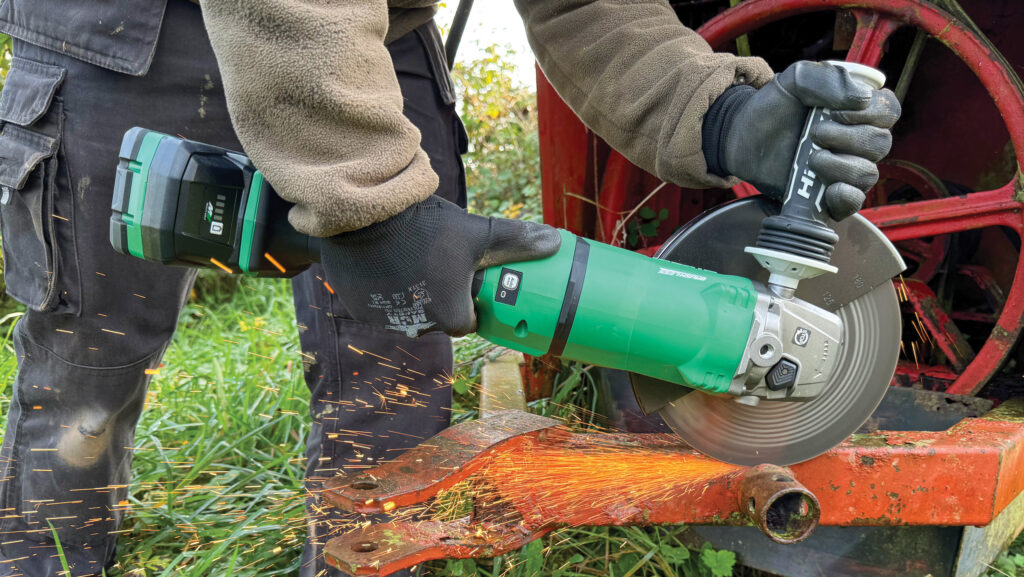
© MAG/Oliver Mark
- Battery system: Single MultiVolt (MV) 18V/36V
- Capacity tested: 4Ah at 36V
- Biggest battery available: 4Ah
- Weight with battery and cutting disc: 5.3kg
- Disc guard: Tool-free
- Disc attachment: Conventional tool-loosened nut
- Electronic brake: Yes
- No load speed: 5,300rpm
- Bare tool online price: £237
- Battery online price: £105 (1x T-PWR 18V 8Ah/36V 4Ah)
Test results
- Continuous cutting time to a charge: 4min 53sec
- Time to cut 50mm in 25mm thick plate: 34sec
Power source
Whoa, the Hikoki… No, this isn’t a line from a nursery rhyme, it’s the name used on a range of power tools that, prior to 2018, wore a Hitachi badge.
Plenty has changed since the rebrand, but battery connectors have stayed the same, so earlier generation kit can still run the latest packs.
This includes the firm’s clever MultiVolt tabless units that can operate at either 18V or 36V, depending on which type of tool they are connected to.
In the case of the G 3623 DA tested here, the higher of the two voltages is used. That means that when it’s allied to a top-of-the range BSL 3640MVT battery, a capacity of 4Ah is made available.
On the other hand, if the same pack was plugged into an 18V tool, 8Ah would be served up.
How does it perform?
During testing – with knees bent, arms stretched, rah rah rah – the Hikoki was the surprise performer of the group.
It cut almost as quickly as the Makita and Metabo, both of which had higher disc speeds on paper.
And, despite the compact proportions of its MultiVolt battery, it put in the longest cutting stint to a charge.
There must be some clever technology inside, as it had by far the lowest battery bulk of the tools on test.
The downside was that it would bog down more readily than its powerful rivals, so it needed a light hand to get the most out of it on particularly tough cutting tasks.
Plus, there was a noticeable fade in power as it ran out of charge, rather than it giving full beans until exhaustion.
Other minor grumbles are the slightly awkward trigger lock button and a conventional tool-loosened disc retaining nut, rather than a neat hand operated version.
A final feature worth mentioning is “auto” mode, engaged using a button on the top of the body. This lowers the disc speed when not cutting to reduce noise, but ramps it up once the tool starts working.
It might be useful on easy jobs, but we found the tool cut better when this was switched off.
Milwaukee M18 FLAG230XPDB 18V
Best for: Disc guard adjustment
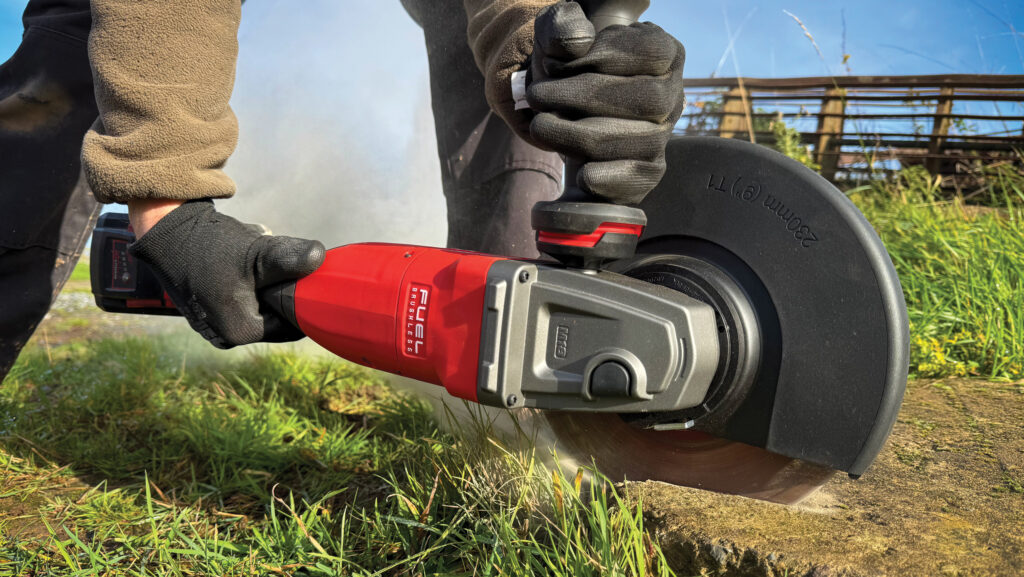
© MAG/Oliver Mark
- Battery system: Single 18V Forge
- Capacity tested: 12Ah
- Biggest battery available: 12Ah
- Weight with battery and cutting disc: 5.6kg
- Disc guard: Tool-free
- Disc attachment: Tool-free
- Electronic brake: Yes
- No load speed: 6,600rpm
- Bare tool online price: £231
- Battery online price: £171
Test results
- Continuous cutting time to a charge: Couldn’t complete
- Time to cut 50mm in 25mm thick plate: 2min 20sec
Power source
While most manufactures have adopted higher voltages for running power-hungry tools, Milwaukee has stuck doggedly to 18V.
The main benefit of this approach is that just one type of battery and charger is required to run any model in the maker’s range.
However, it doesn’t always work in practice, as a large tool will generally require a higher capacity unit; one that would be overly bulky when fitted to something compact such as an impact driver.
The M18 230mm cordless grinder falls very much in the large battery camp and is best teamed with one of the latest 12Ah Forge packs.
These are higher powered, faster charging and promise to last longer than regular Red Lithium-ion versions.
How does it perform?
Normally, Milwaukee power tools ace our tests, so expectations for the M18 were high.
However, on this occasion, it couldn’t keep pace with the competition. Though fine for light work, it was painfully slow to slice through our 25mm plate and repeatedly cut out while doing so.
The massive battery held plenty of charge, but we eventually stopped trying to flatten it as the task became too tedious.
Admittedly, our testing was harsh, but all other models involved put in a respectable performance.
It begs the question whether Milwaukee needs to rethink the 18V policy on its biggest tools, perhaps fitting two batteries and going to 36V.
On the upside, those who want to cut thinner steel, or do grinding work, will likely get ample work to a charge.
Cutting performance aside, we liked the trigger mechanism, it was easy to handle and we were particularly impressed with the disc guard.
This has the widest range of movement in the test group and it was also the easiest to adjust.
How do they compare with a corded alternative?
It’s a big ask for a cordless grinder to match the performance of one that’s plugged into the mains, but a couple of the tools tested here came mighty close.
Both the Metabo and Makita rivalled the test farm’s corded model for cutting speed and most of our contenders had sufficient battery capacity to carry out a respectable amount of work to a charge.
Repeatedly cutting into 25mm plate was a bit mean, but three of the test fleet stood up to the challenge and they’d be even more impressive attacking a piece of box section or angle iron.
However, this performance comes at a cost.
It’s not so bad for those already armed with a few high-capacity batteries, as the bare tools range from £231 to £253 online.
Gearing up from scratch, however, could require an outlay of more than £450.
As for which we’d pick? Metabo clinches it for its sheer brute force, but Makita and Hikoki come a close second.

